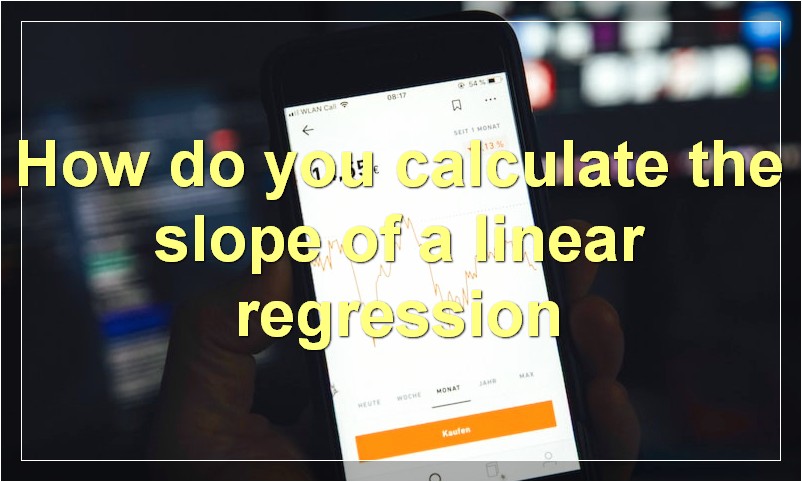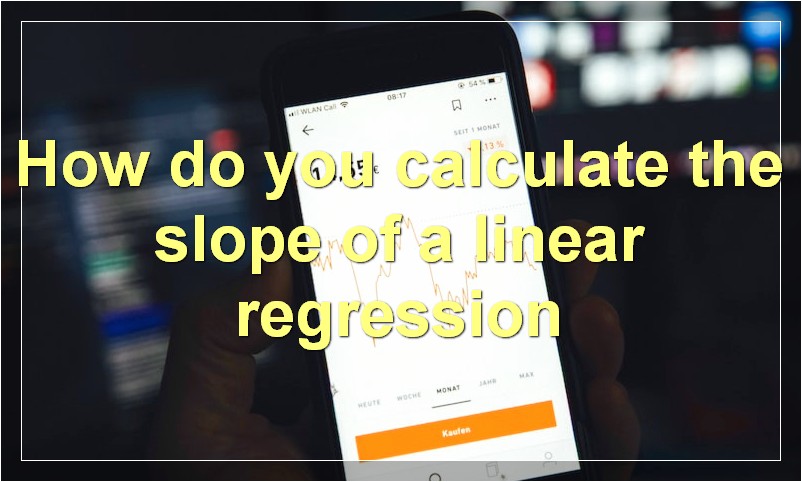If you’re not careful, interpreting the slope of a linear regression can be tricky. In this article, we’ll show you how to do it correctly.
What is the slope of a linear regression
A linear regression is a mathematical model that describes how one dependent variable changes in relation to another independent variable. The slope of a linear regression is the ratio between the change in the dependent variable and the change in the independent variable. In other words, it tells you how much the dependent variable changes for every unit of change in the independent variable.
How do you calculate the slope of a linear regression

There are a few different ways to calculate the slope of a linear regression, but the most common is to use the least squares method. This involves finding the line that minimizes the sum of the squared errors between the line and the data points.
To do this, you first need to find the equation of the line in slope-intercept form (y = mx + b). Then, you can plug in the x- and y-values for each data point and calculate the error. Once you have the errors for all of the data points, you can square them and add them up. This will give you the sum of the squared errors.
To find the line that minimizes the sum of the squared errors, you need to take the derivative of this equation with respect to m (the slope) and set it equal to 0. This will give you an equation that you can solve for m. Once you have the value of m, you can plug it back into the original equation to get the value of b (the intercept).
Once you have the values of m and b, you can plug them into the equation y = mx + b to get the equation of the line that best fits your data. This line is your linear regression.
What does the slope of a linear regression tell you
The slope of a linear regression is the measure of how much the dependent variable changes in relation to the independent variable. In other words, it tells you how much the y-variable changes for every unit increase in the x-variable. The slope can be positive or negative, depending on the direction of the line. A positive slope indicates that as the x-variable increases, so does the y-variable. A negative slope indicates that as the x-variable increases, the y-variable decreases. The slope is also a measure of the steepness of the line. A steep slope indicates a large change in the y-variable for a small change in the x-variable, while a shallow slope indicates a small change in the y-variable for a large change in the x-variable.
What is the significance of the slope of a linear regression
The slope of a linear regression is significant because it tells us how much the dependent variable changes for every one unit change in the independent variable. In other words, the slope is a measure of the relationship between the two variables. A high slope means that there is a strong relationship between the two variables, while a low slope means that there is a weak relationship.
How does the slope of a linear regression impact the interpretation of the results
The slope of a linear regression line is the measure of the change in the dependent variable, y, for each unit of change in the independent variable, x. In other words, it represents the rate of change of y with respect to x. The interpretation of the results of a linear regression depends on the sign of the slope. If the slope is positive, it indicates that as x increases, y also increases. Conversely, if the slope is negative, it indicates that as x increases, y decreases.
The magnitude of the slope can also be interpreted. A large positive slope indicates a steep line, which means that there is a large increase in y for each unit increase in x. A small positive slope indicates a shallow line, which means that there is only a small increase in y for each unit increase in x. Similarly, a large negative slope indicates a steep line, which means that there is a large decrease in y for each unit increase in x. A small negative slope indicates a shallow line, which means that there is only a small decrease in y for each unit increase in x.
What are the implications of a high or low slope in a linear regression

A high slope in a linear regression indicates a strong relationship between the independent and dependent variables. This means that as the independent variable increases, the dependent variable is likely to increase as well. A low slope, on the other hand, indicates a weak relationship between the two variables. This means that changes in the independent variable are not likely to have a significant effect on the dependent variable.
How does the slope of a linear regression affect the predictive power of the model
In order to answer this question, we must first understand what a linear regression is. A linear regression is a statistical model that is used to predict a quantitative outcome based on one or more predictor variables. The slope of the linear regression line represents the relationship between the predictor variable and the outcome variable. The steeper the slope, the stronger the relationship between the two variables.
Now that we know what a linear regression is and what the slope represents, we can answer the question. The slope of the linear regression line affects the predictive power of the model in that a steeper slope indicates a stronger relationship between the predictor variable and the outcome variable. This means that a model with a steep slope is more likely to accurately predict an outcome than a model with a shallow slope.
In what situations is the slope of a linear regression not meaningful
There are a few situations in which the slope of a linear regression is not meaningful. One such situation is when there is no linear relationship between the independent and dependent variables. This can happen if the data points are spread out randomly with no clear pattern. Another situation in which the slope is not meaningful is when the independent variable is categorical instead of quantitative. For example, if you are predicting someone’s height based on their gender, the slope would not be meaningful because gender is not a continuous variable. Finally, the slope may not be meaningful if the dependent variable has been transformed in a non-linear way, such as taking the logarithm or square root.
What other factors should be considered when interpreting the results of a linear regression
There are a few other factors to consider when interpreting the results of a linear regression. First, consider the overall fit of the model. A model with a good fit will have a high R-squared value and low residuals. Second, take a look at the individual coefficients and see if they make sense in the context of your data. A coefficient that is far from zero is likely to be significant. Finally, consider the standard errors of the coefficients and make sure they are reasonably small.
What are some potential problems with using linear regression to analyze data
Linear regression is a statistical technique used to predict future values based on past values. It is a form of predictive analytics and is often used in business and economics to forecast sales, demand, or other trends. While linear regression can be a powerful tool, there are some potential problems that can occur when using this method to analyze data.
One issue that can arise is called heteroscedasticity, which occurs when the dependent variable (the thing being predicted) is not equally distributed across all values of the independent variable (the predictor). This can lead to inaccurate predictions and results. Another potential problem is multicollinearity, which occurs when there are high correlations between independent variables. This can also lead to inaccurate predictions and results.
Both of these issues can be addressed by transforming the data before running the linear regression analysis. However, if the data is not transformed properly, these issues can still lead to problems with the accuracy of the predictions.

